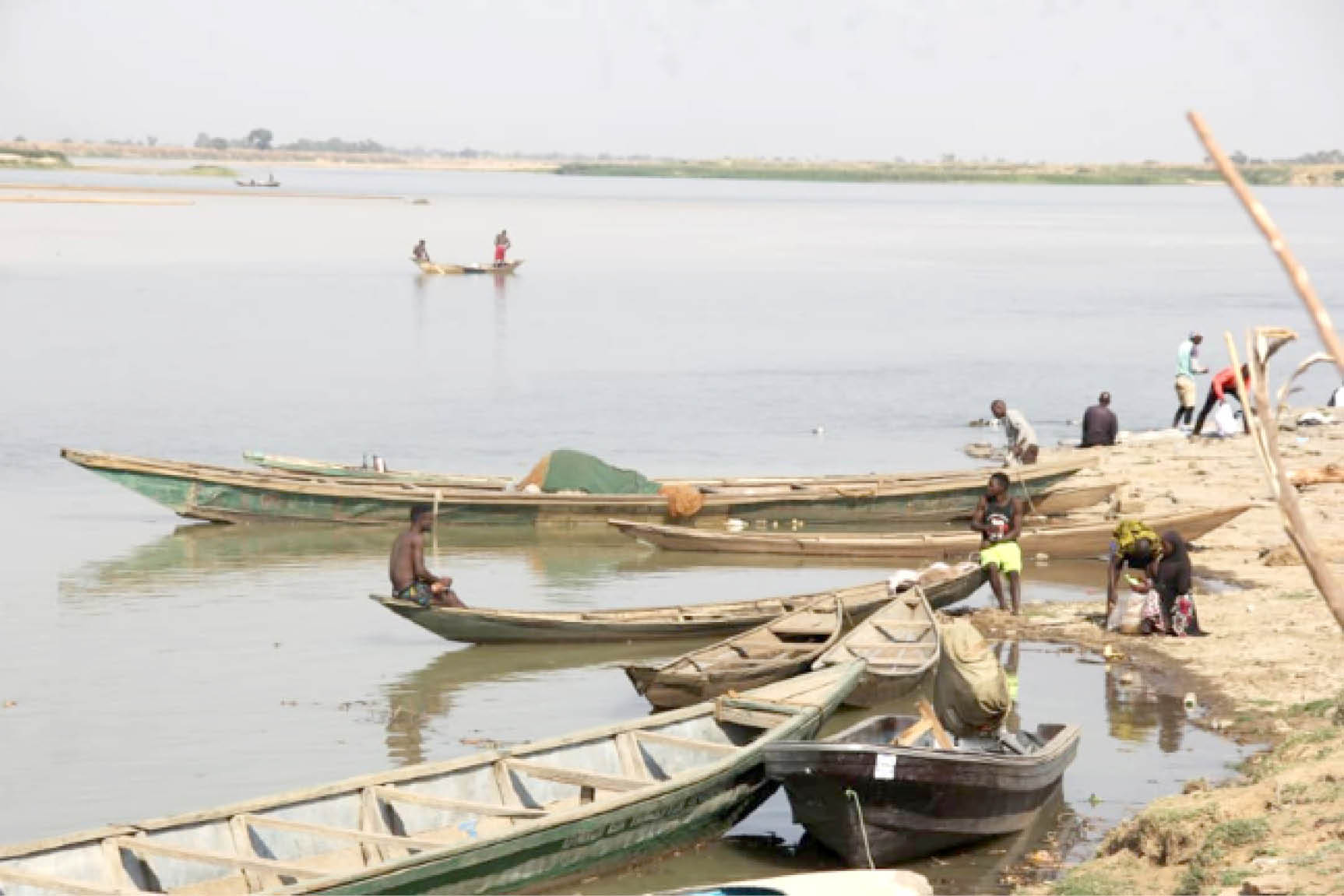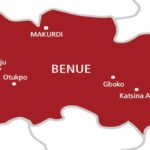For people travelling along the bridge in Numan town of Adamawa State, the spectacular sight of the river flowing underneath, fishing activities and green vegetation, is particularly exciting. Even more exciting is the colourful mixture of brown and blue waters at the confluence of rivers Gongola and Benue.
From the comfort of their seats inside the vehicle, curious passengers have a clear view of the brown water from Gongola river running into the Benue River and the mixture flowing along, partly brown and partly blue.
- Ikorodu Bois, Emmanuella, Sallah, others nominated for 2021 Nickelodeon’s Kids’ Choice Awards
- Stop onslaught on Fulani Communities – Police warn
The confluence is a cultural and commercial meeting point for a number of ethnic groups inhabiting the river valleys. Fishing canoes line up the river bank as dry season farmers cultivate the land by the riverside.
Nostalgic folks often recall the days when people from afar trooped to watch cultural displays and fishing festivals while barges from England loaded cotton and groundnut at the John Holt warehouses.
Siltation is a common environmental problem along the length of River Benue but locally, fishermen and fish traders around this confluence blame River Gongola for recharging the Benue with nothing but sand.
Gongola River, which serves as the main tributary of Benue, originates from the eastern slopes of Jos plateau, running northeasterly to Nafada.
It turns south and then southeast to meet its main tributary, River Hawal and then flows south to join the River Benue in Numan.
Before reaching Numan, the river is impounded by Kiri Dam, constructed by the government for irrigation purposes. Lunguda and Kanakuru tribes populate the communities around the dam.
The Benue river starts from the Adamawa Plateau of northern Cameroon, first flowing west and then eastwards through the town of Garoua and Lagdo -where the Cameroonians have today built a hydroelectric dam and reservoir, into Nigeria.
The river flows south of the Mandara mountain ranges of the Allantika ridge and then cascades down swiftly into Yola and Jimeta in Adamawa State.
The river traverses through mostly Bwatiye communities, picking up the Gongola river as its main tributary in Numan.
The Benue River traverses the length of Taraba State from Karim Lamido and down to Ibi and Makurdi before meeting the Niger at Lokoja. Other large tributaries are the Mayo Kabbi, Taraba River and River Katsina-Ala.
Chief Timawus Mathias, the spokesman of the Bachama Kingdom who holds the title of Nzobyalata Hama Bachama, noted the economic and cultural importance of River Benue in the lives of communities it traverses.
The Bachama mouthpiece said the Benue River was originally called the Tchadda but oral tradition had it that Scottish explorer William Baikie, who led an expedition in 1854 to establish how far the Benue River cuts into the Nigerian hinterland, was reported to have enquired of the name from the Batta natives upstream of Jimeta, Njoboliyo and Bole.
They told him it was Gbinwei which transliterates as ‘the place of death’ owing to the many deaths recorded in many boat mishaps.
He noted that of the 1,400 km of this major tributary of the Niger River, nearly 600 km traversed Adamawa State, snaking along the Allantika Mountains.
The river is about 1,400 km long. In the past, navigation was possible for nearly the whole length in the rainy season, lamenting the fact that the river wilted to provide settlements and farmlands deep into the river bed.
“One can behold the Gongola as it empties its waters into the Benue in distinct colours – the smaller brown and the main Benue, blue”.
Timawus recalled the time when the water provided a cheap means of transportation across its length and cultural activities in the valley attracted people from far, lamenting the effect of environmental degradation and conflict on the tourist potentials of Numan and environs.
He believes that the resources of the valley if properly utilised could assist the country in the quest to diversify the economy away from oil by earning a huge amount of revenue in foreign currency.
“The Benue river is of great economic and tourism potential. Apart from its navigation for trade and transportation purposes, for years it has played a role in bringing together the farming communities of the Jukun, the Jenjo, the Bachama and the Mbula in a cross-cultural mutual existence with Fulani herders.
“Annual fishing festivals include the now moribund Njuwa Fishing Festival, moribund because the once rich lake has been lost to perennial silting.

“There is also the annual Vunon Festival more popularly known as Farai-Farai which holds in May.
“The communities of Demsa, Mbula, Numan and Lamurde come together to celebrate their common deities and declare open the farming season.
“It is adjudged the biggest festival in four days of dancing, singing, camping and sales of ornaments, a variety of pots and decorated calabashes.
“Today, it is a trade fair of sorts with camping of tourists from all over the state and beyond.
“The Fulani also in May, hold their annual Sharro festival in Demsa, a celebration of the river’s blessing of grassland for cattle. Obviously, all the communities down the river connect lifetimes and life itself to their different faiths.”
He believes the Benue River is central to the lives of these riverine communities.
They wait for the river to overflood the farmlands in the rainy season, setting the stage for dry season agriculture and leaving behind lush Savannah grass for grazing by Fulani herdsmen, noting that until recent conflict, the Fulani herdsmen and the farming communities had been in a close partnership which resulted in mutual benefit.
The veteran broadcaster lamented continued neglect of the tourism and economic potentials of the valleys, saying “the failing Savannah has forced conflict between farmers and herders over the depleting land resources.
“If the government turned its attention on this remarkable revenue earner, it could help mitigate the shortfalls from our volatile oil economy and restore the peace and tranquillity the communities once knew.
“Significantly large imports (particularly petroleum) could be transported up the river, and cattle, smoked fish, cotton and groundnuts could be exported down the river to the South and even the sea.”
John Ngamsa, an academic and former commissioner, Adamawa State Ministry of Information and Culture, called for immediate dredging of the rivers to preserve the aquatic environment, and keep the communities together, saying the rate at which sand is puling up in the river threatens livelihood and tourism potential.
He noted that dredging, documentation and showcasing of cultural performances and artefacts will surely attract tourists’ dollars to the state.
Amazed by the multicultural nature of the communities inhabited by aborigines and people from other places, Ngamsa saw a golden opportunity that Nigeria needs to grab.
He said his dream was to make the tourists’ dollar the people’s dollar, explaining that “when a tourist buys an artefact like the colourful and artful calabashes, the money goes straight to the seller.”
“The boat regatta, which has recently been re-enacted at the wake of installation of the Bachama kings, was used to display how migration took place.
“It is something people like to see. It goes along with some dances that people of Mburu and Numan do to commemorate or celebrate the hunt of big river animal.
“It is interesting standing on the bridge in Numan and seeing the two rivers converse by the right side on the road to Gombe.
“When you look at that belt, you are likely to be interested in the composition, as well as the kind of people that inhabit the area. Basically, if you look at the Benue, there are the Bwatiye, Bachama settlements, you also meet Mbula people on the other side, as well as Bare and Kabawa people.
“There are other tribes who settled in the communities and engage in the fishing profession. It is not only done by indigenes; outsiders are also part of it.”
As a child in the late sixties and early seventies, Ngamsa enjoyed the sight of barges coming from Liverpool.
The cotton and groundnut pyramids made Numan a remarkable depot and centre of commerce.
He could vividly recall the festivals, the wrestling in Mburu and in Opalo.
Young men wrestle from village to village to show they were strong to face the next farming season and all kinds of cultural artefacts, bows and arrows were displayed.
For Abiola Augustine, a 25-year-old Jukun man, the golden days of fishing trade and related activities have gone with the gradual degradation of the aquatic environment. Fishing is part of Jukun culture and a family business.
He started fishing at the age of five and never went to school, yet he contemplates quitting because the future seems bleak as the water is becoming shallow and fish is no longer available. Sand is taking over the water.
“The local government promised to give us fishing nets but that will be useless.
“The only solution is to evacuate the sand that has accumulated in the river. You can see more sand coming from Gongola river,” he noted.
Another Fisherman of Janjo extraction, Baba Numan, complained of the dwindling fortune from fishery and related trades, saying the problem is worse this year as the river has become too shallow.
A fish seller, Rhoda James, and a fisherman, Moses Ayuba, both said it was becoming difficult to pay school fees for their children as fish has become scarce.
Attempt to speak to the Commissioner Ministry of Culture and Tourism was not successful as at the time of filing this report.
Government’s side
Solomon Garnvwa, the Acting Director, Hotels and Tourism at the Adamawa State Ministry of Culture and Tourism said there were plans by the state government to set up an aqua tourism site at Kiri dam.
He called on the private sector to partner with the present administration in the state to develop the tourism potentials of Gongola and Benue rivers.
“It is good to take advantage of the water resources, vegetation and rich culture in the river valleys. We have a large number of hippopotamus in the dam.
“A plan was once conceived by the state government to establish a tourist site at Kiri Dam where tourists could camp and engage in fishing, speed boat racing and witness cultural performances by local tribes. The private sector should come in to help develop these potentials”, Garnvwa stated.

 Join Daily Trust WhatsApp Community For Quick Access To News and Happenings Around You.
Join Daily Trust WhatsApp Community For Quick Access To News and Happenings Around You.

